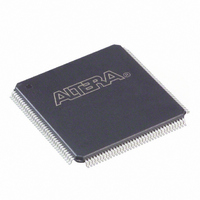EP1C3T144A8N Altera, EP1C3T144A8N Datasheet - Page 45

EP1C3T144A8N
Manufacturer Part Number
EP1C3T144A8N
Description
IC CYCLONE FPGA 2910 LE 144-TQFP
Manufacturer
Altera
Series
Cyclone®r
Datasheet
1.EP1C3T100A8N.pdf
(47 pages)
Specifications of EP1C3T144A8N
Number Of Logic Elements/cells
2910
Number Of Labs/clbs
291
Total Ram Bits
59904
Number Of I /o
104
Voltage - Supply
1.425 V ~ 1.575 V
Mounting Type
Surface Mount
Operating Temperature
0°C ~ 85°C
Package / Case
144-TQFP, 144-VQFP
Lead Free Status / RoHS Status
Lead free / RoHS Compliant
Number Of Gates
-
Available stocks
Company
Part Number
Manufacturer
Quantity
Price
Company:
Part Number:
EP1C3T144A8N
Manufacturer:
ALTERA
Quantity:
248
Part Number:
EP1C3T144A8N
Manufacturer:
ALTERA
Quantity:
20 000
Chapter 7: HardCopy II Devices
DC and Timing Specifications
PowerPlay Power Analyzer
DC and Timing Specifications
© March 2010 Altera Corporation
f
1
The value obtained from the EPE is only an estimation and should not be used as a
specification. The accuracy of the EPE results is dependent on how close your input of
the design information into the EPE resembles that of the final design.
The PowerPlay Power Analyzer tool in the Quartus II software is a power analysis
tool that helps you calculate your design power consumption accurately to ensure
thermal and power supply budgets are not violated after your design is complete. The
PowerPlay Power Analyzer tool requires your design to be synthesized and fitted to
the target device. Availability of information such as design resources, how the
design is placed and routed on the target device, and the I/O standards assigned to
each I/O cell allow the PowerPlay Power Analyzer tool to provide accurate power
estimation.
The process of using the PowerPlay Power Analyzer tool consists of three parts:
specifying sources of input data, specifying operating conditions, and running the
PowerPlay Power Analyzer tool.
The input data consists of the signal activities data (toggle rates and static
probabilities) of the compiled design. Signal activity data can be derived from
simulation results, user assignment in the Assignment Editor, user-defined default
toggle rate, and vectorless estimation.
The operating conditions include device power characteristic, ambient and junction
temperature, cooling solution, and board thermal model, all of which can be set in the
Quartus II software.
The PowerPlay Power Analyzer tool calculates the dynamic, static and I/O thermal
power consumption, current consumed from voltage source, a summary of the signal
activities used for analysis, and a confidence metric that reflects the overall quality of
the data sources for the signal activities.
For more information about the Signal Activity Files (.saf) and how to create them,
refer to the
For more information about the PowerPlay Power Analyzer tool, refer to the
PowerPlay Power Analysis
The automotive-grade HardCopy II devices have the same absolute maximum
ratings, recommended operating conditions, and DC electrical characteristics as their
equivalent industrial-grade devices. The timing specifications is equivalent to the
speed grade of the prototype FPGA, except when noted as part of the HardCopy II
timing specification design review process.
The operating junction temperature, T
devices is from –40°C to 125°C. For more information about the DC characteristics of
the industrial-grade HardCopy II devices, refer to the
and Operating Conditions
However, the following exceptions apply:
Quartus II Simulator
chapter in volume 1 of the HardCopy Series Handbook.
chapter in volume 3 of the Quartus II Handbook.
chapter in volume 3 of the Quartus II Handbook.
j
, for the automotive-grade HardCopy II
DC and Switching Specifications
The Automotive-Grade Device Handbook
7–3












